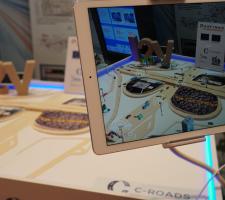
For quite a number of years, it was assumed that the connectivity required for cooperative ITS (C-ITS) applications and autonomous vehicle (AV) operations would be catered for by a bespoke communications solution/protocol. This would provide localised ad hoc communication in a manner similar to Wi-Fi, and the dedicated bandwidth/near-zero latency characteristics required for safety applications in particular.
In more recent times, a powerful group of industry stakeholders, consisting principally of telecoms companies, chipset makers and some of the vehicle manufacturers, has made a vociferous case for this to change. They advocate the use of cellular telephony, in the form of 5G. In both the mass and specialist media, the direct question is being asked: “Is 5G necessary for AV operations?”
Many of these articles ignore two inconvenient truths: first, that a full, final 5G standard is not expected to be published until the end of 2019 at the earliest - and second, that significant development and testing will be needed to confirm the characteristics and robustness required for C-ITS applications thereafter.
Critics point to vested interests, and a desire for profitability and product differentiation. They argue that to delay is to discount an already-existing - and thoroughly proven - solution which is ready to deploy and would improve road users’ safety immediately. They further refute the contention that the choice between a bespoke solution and 5G is a permanently closed case of ‘one or the other, but not both’.
A line in the sand
From mid-2020,
It will be doing so using wireless broadcast technology based on ITS-G5, an evolution of the wireless 802.11p standard which operates in the 5.9GHz frequency band.
Manfred Harrer, Asfinag’s head of department, telematics services, and Peter Meckel, programme manager, C-ITS, say that the decision to run with ITS-G5 was based on a number of carefully
considered points.
“There’s a giant marketing effort being generated around the suitability of 5G for C-ITS and autonomous driving applications but prod that bubble and it’ll burst,” Meckel says. “What we have at the moment is a theoretical discussion about what might be possible with the new technology. We saw the same happen previously with 4G.”
It is also about dedicated use and potential sharing of the frequency spectrum currently reserved for ITS, he goes on: “There are a lot of different interests involved but currently, given where we are with 5G definition, for C-ITS applications ITS-G5 is the only solution out there.”
ITS-G5 is a certificated open-channel solution which offers guaranteed performance. Also, its particular performance characteristics are worth noting: it effectively creates a wireless ‘hotspot’ around safety-critical or otherwise noteworthy nodes on the road network.
Inexpensive ‘safety hotspots’
These ITS-G5 hotspots have a radius of only a few hundred metres and are a fairly inexpensive solution to deploy, especially for an organisation such as Asfinag which already has in place a network of distributed IP interfaces. “Although 5G cell sizes are going to be much smaller than those of LTE/3G there will still be a much greater cost associated with realisation,” he explains. “Automotive applications, and in particular safety applications, present particular challenges for cellular networks. The requirement is for very good-quality connections and very low latencies. That performance has to be guaranteed in crowded situations, such as when there are incidents or high volumes of traffic. You need reserved, guaranteed bandwidth. The broadcast nature of ITS-G5 and its congestion-control algorithms take account of this but we’re yet not seeing any discussions of how this will be accounted for in 5G - we face a situation where the cellular networks could become overloaded just at the times and places when the highest levels of performance are needed most.”
By comparison with ITS-G5’s localised nature, a 5G-based solution would only provide linear coverage along a corridor, Harrer states.
Like Meckel, he notes that cost is a persistent issue. This is especially so when one considers the nature of strategic road networks. Historically, deployment of succeeding generations of cellular networks has begun in densely-populated centres, where there is plenty of custom and so a strong business case for revenue-generating services such as streaming music and video, for instance. By contrast, strategic transport networks, both road and rail, tend to traverse the often sparsely inhabited gaps between major towns and cities. Because of this there is a less clear mechanism by which to financially support safety applications, especially on the more remote sections of a transport network.
“So, who pays for the SIM cards which will enable network access and who decides which applications are free or not, or how the costs might be shared between the actors?” asks Harrer.
Demanding environment
Meckel highlights the potential delays to delivering safety improvements of waiting for 5G - a serious consideration for any infrastructure operator, whether public or private.
“The assertion that the ITS-G5/5G choice is a binary one does not stand up to challenge,” he begins. “Those working hard to deploy solutions now are also working very hard to achieve hybrids, and hybrid C-ITS will get specified in the near future. It’s simply not true that the door’s closed once the choice is made to go with ITS-G5. From a road operator’s perspective, we’ll use any relevant communications medium - if a new one arises which has utility, it will be considered.”
A question does hang over how long, from the publication of a complete standard, it will take to see working 5G-based C-ITS solutions. “The worst-case thinking alludes to the years of testing which have given us ITS-G5,” Meckel goes on. “In reality, I don’t think it would take that long. A lot of the preparatory work done during the evolution of ITS-G5 is directly transferable to 5G. That will help to compress timescales.”
With hybrid solutions on the way, Harrer feels that it is perhaps time for the emphasis of the debate to shift away from straightforward choice. “Lots of C-ITS applications and use cases are still being defined,” he explains. “The Day One safety applications have been chosen because of their relative simplicity and low-bandwidth requirements. Those which follow will be more complex and more data-hungry. There will be a space for 5G, for example in applications such as automated driving or the provision of HD maps. It could well be that 5G turns out to be a better choice for applications beyond the safety hotspots and others envisaged for the 2018-20 timeframe. It might be a better idea for 5G’s supporters to concentrate their thinking there, rather than on mirroring Day One applications on a like-for-like basis.”
Day One C-ITS applications
Asfinag’s involvement in ITS development goes back more than a decade. One C-ITS highlight was the company’s participation from 2012 in a cooperative corridor initiative between Austria, Germany and the Netherlands which involved multiple road operators.
Its Day One C-ITS applications are harmonised with the C-ROADS platform. This is a joint initiative of European Union member states and road operators for testing and implementing C-ITS services in light of cross-border harmonisation and interoperability. It forms the basis of the European Commission’s Delegated Act on C-ITS, which is due to become mandatory once published this year.
Day One applications encompass messages about traffic jams, hazardous locations, roadworks and slow or stationary vehicles, as well as localised weather information and speed advice to harmonise traffic movements and so help combat congestion. Later applications will be more sophisticated and pave the way to fully autonomous driving.












